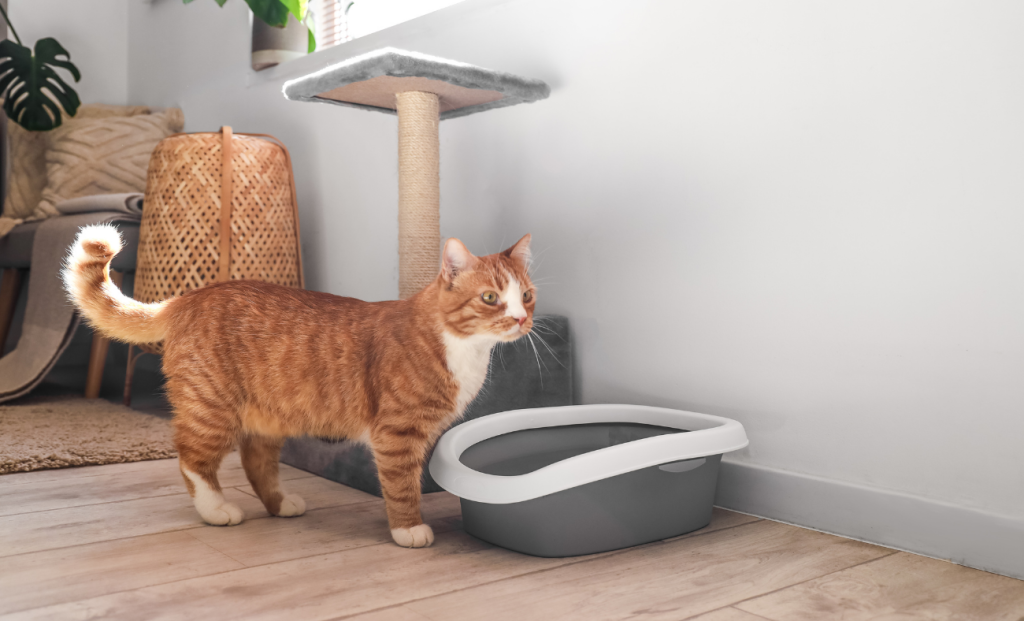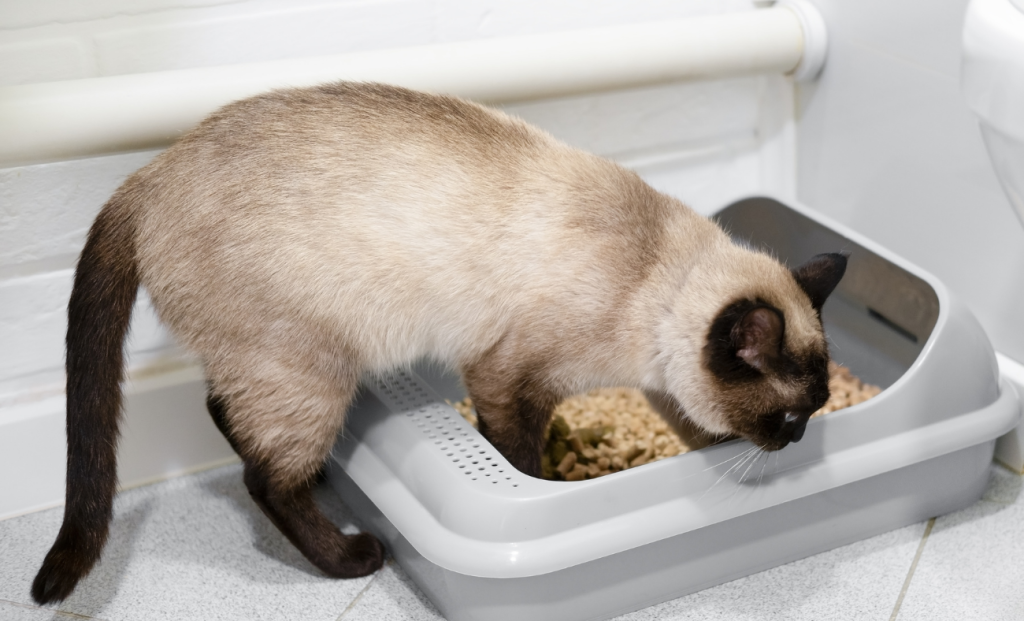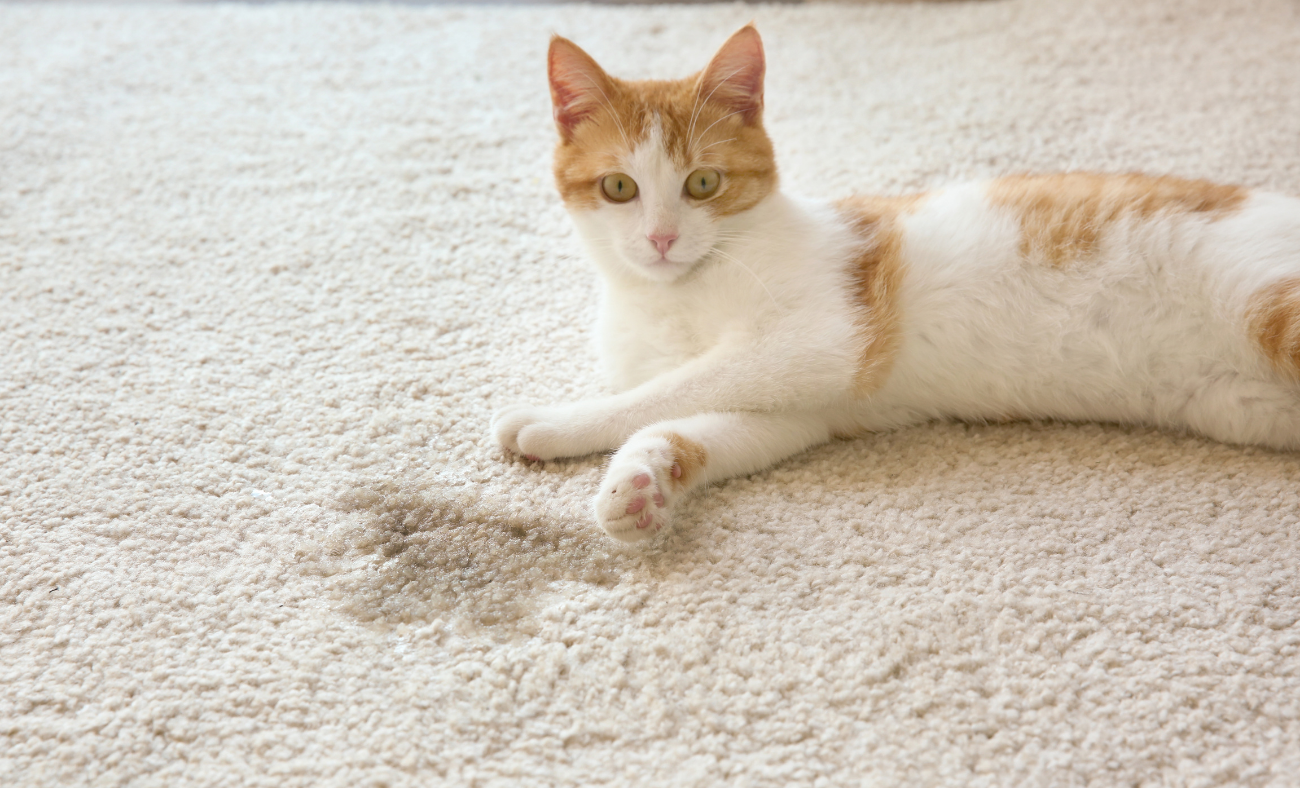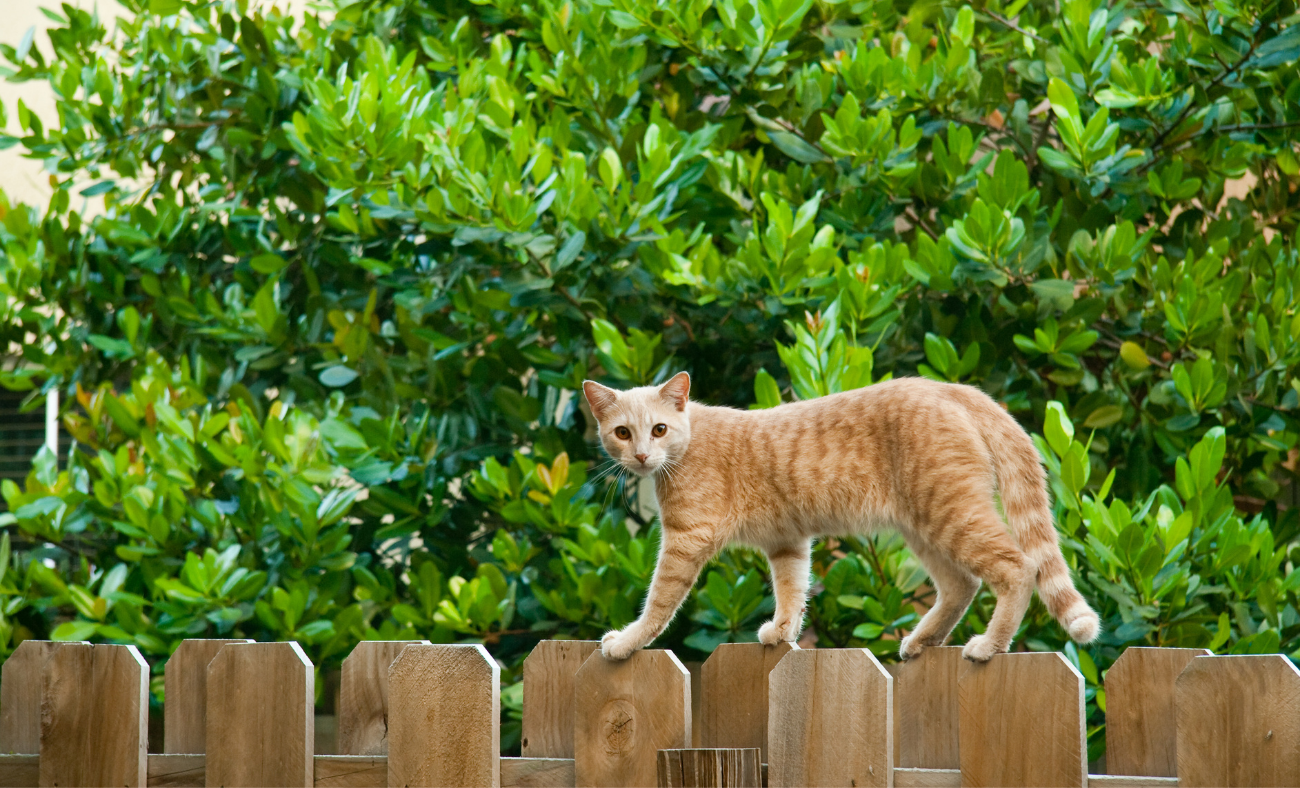Picture the moment when you discover your previously perfect cat has left you an unmistakable message……….on your favorite rug.
It’s 7 AM. You’re rushing to get ready for work when you step into something wet and warm in your hallway. Your heart sinks as you realize what’s happened. Your cat – the same cat who’s used their litter box faithfully for years – has just voted against something in your household with the most powerful ballot they possess.
That first inappropriate elimination feels like betrayal. Like your cat has suddenly forgotten everything you thought they understood about living together. The frustration is immediate and overwhelming. “Why would they do this?” becomes the question that haunts every interaction.
But what if I told you that your cat isn’t being spiteful or forgetful? What if that wet spot on your rug is actually sophisticated communication about something that’s making them feel unsafe in their own home? A very obvious representation of cat anxiety symptoms.
Through my studies in feline anxiety, I’ve learned that inappropriate elimination represents one of the most direct forms of stress communication cats possess. When cats stop using their litter box, they’re not breaking rules – they’re desperately trying to tell us something crucial about their emotional state.
The Biology Behind the Message
Here’s what we know about litter box problems: elimination represents one of the most vulnerable activities in a cat’s daily routine. In the wild, cats are completely defenseless while eliminating, making this activity highly sensitive to any environmental factors that compromise their sense of safety.
When cats feel secure, they naturally seek out private, predictable locations for elimination. The litter box represents the perfect solution – a designated area that provides necessary privacy while meeting their instinctual needs for appropriate substrate and location.
But when cats experience cat anxiety symptoms, this same litter box can begin feeling like a trap rather than a sanctuary. The vulnerability required for elimination becomes magnified when cats feel uncertain about their environmental security.
Understanding this biological reality transforms how we interpret litter box avoidance. Your cat isn’t choosing to be difficult. Their survival instincts are telling them that elimination in their usual location feels too risky given their current stress levels.
Recognizing the Early Warning Signs
Most cat parents miss the subtle behavioral changes that precede obvious litter box problems. These signs of stressed cat behavior often appear weeks before cats stop using their boxes entirely.
You might notice your cat approaching the litter box more cautiously than usual. They may spend more time positioning themselves before eliminating, or seem unusually alert during the process. These changes indicate that your cat is beginning to feel uncertain about their elimination security.
Changes in elimination timing also provide important early warnings. Cats experiencing stress often begin avoiding peak household activity periods, waiting for quieter times when they feel less vulnerable during elimination.
Some cats develop hesitation behaviors around litter box areas. They may approach the box, pause, and walk away without eliminating. This behavior suggests that cats want to use appropriate elimination areas but something about the environment is triggering their anxiety responses.
The development of behavioral issues in cats around elimination often follows predictable patterns once you understand what to look for. Cats rarely progress immediately from normal litter box usage to complete avoidance. The escalation typically includes subtle changes in approach, timing preferences, and positioning within the box itself.
Environmental Triggers That Destroy Litter Box Confidence
Learning about environmental factors that contribute to elimination anxiety reveals how many household changes can trigger feline anxiety. These triggers often seem insignificant to humans but represent major security disruptions from a cat’s perspective.
Litter box placement affects cats’ willingness to use appropriate elimination areas more than most people realize. Boxes located near noisy appliances, high-traffic areas, or spaces where cats can be surprised create ongoing stress that eventually leads to avoidance behaviors.
Multi-cat household dynamics create particularly complex elimination challenges. Competition for resources, territorial disputes, or social hierarchy pressure around litter box access can trigger anxiety in cats who feel unable to eliminate safely in shared spaces.
Even single-cat households face environmental factors that can compromise litter box security. Changes in household routines, visitor schedules, or family stress levels affect cats’ perception of elimination safety in ways that gradually erode their confidence in established elimination areas.
The substrate and maintenance factors also influence cats’ elimination comfort. Changes in litter type, cleaning products, or box cleanliness standards can create enough sensory disruption to trigger cat anxiety during vulnerable elimination activities.

The Psychology of Elimination Security
Understanding why cats need to feel completely secure during elimination helps explain why anxious cat behavior often manifests through litter box problems. Elimination requires sustained focus and physical positioning that allows quick escape if threats appear.
When cats experience chronic anxiety, they become increasingly vulnerable. Their nervous systems remain in heightened alert states that make relaxed elimination feel impossible, even in previously comfortable locations. This vulnerability is the reason that inappropriate elimination quickly becomes one of the more obvious cat anxiety symptoms.
The territorial aspects of elimination add another layer of complexity to litter box anxiety. Cats use elimination areas to establish and maintain territorial boundaries, making these locations psychologically significant beyond just their practical elimination function.
Disruptions to territorial security – through household changes, new pets, or environmental modifications – can trigger protective responses where cats begin marking inappropriate areas to reestablish territorial boundaries they feel are threatened.
Common Patterns in Litter Box Avoidance
Different types of inappropriate elimination communicate different anxiety messages that help identify specific triggers and solutions. Understanding these patterns provides valuable insights into cats’ emotional states and environmental needs.
Cats who eliminate near but not in the litter box often indicate location anxiety rather than substrate preferences. These cats want to use appropriate elimination areas but something about the box itself – placement, accessibility, or associated stressors – creates enough anxiety to prevent normal usage.
Elimination in soft surfaces like beds, clothing, or carpets typically indicates comfort-seeking behavior. Cats choosing these areas are often looking for locations that provide additional security through familiar scents and textures that help them feel safer during vulnerable elimination activities.
Some cats develop timing patterns around inappropriate elimination that correlate with specific household stressors. Elimination problems that occur during family departures, arrivals, or high-activity periods suggest that cats are responding to environmental stimulation levels that overwhelm their ability to feel secure.
The frequency and urgency of inappropriate elimination also provide important information about anxiety severity. Cats with occasional accidents may be experiencing mild environmental stress, while frequent elimination problems suggest more significant anxiety that requires comprehensive analysis and intervention.
Medical vs. Behavioral Elimination Issues
Before addressing any elimination problem as cat anxiety, it’s crucial to rule out medical causes that can create similar symptoms. Urinary tract infections, digestive issues, arthritis, and other health problems can cause elimination changes that require veterinary treatment rather than environmental modification.
The timing and pattern of elimination problems often help distinguish between medical and behavioral causes. Medical issues typically produce consistent symptoms that don’t correlate with environmental changes, while anxiety-related elimination problems often fluctuate based on household stress levels.
Medical elimination problems may include obvious discomfort during elimination, changes in elimination frequency or volume, or physical symptoms like straining or vocalization during elimination attempts. These signs warrant immediate veterinary evaluation regardless of suspected behavioral factors.
Behavioral elimination problems typically correlate with environmental changes, household stressors, or anxiety triggers that create patterns connecting elimination issues with specific circumstances or timing rather than consistent physical symptoms.
The Social Dynamics of Multi-Cat Elimination
Households with multiple cats face unique challenges around elimination anxiety that require understanding complex social dynamics affecting resource access and territorial security. Competition for litter box access creates stress that can trigger inappropriate elimination in vulnerable cats.
Some cats develop elimination anxiety specifically around shared resources, feeling unable to use litter boxes that smell like other cats or waiting for private access that never feels secure enough. These cats may eliminate appropriately when they have exclusive access but avoid shared elimination areas during busy household periods.
The placement and number of litter boxes significantly affects multi-cat elimination success. Insufficient boxes, poor placement, or inadequate privacy can create territorial pressure that triggers cat stress signs in socially sensitive cats.
Understanding how to calm a stressed cat in multi-pet households often requires addressing elimination resource distribution and accessibility rather than just providing additional boxes in existing locations.

Environmental Solutions for Elimination Anxiety
Creating elimination environments that support cats’ psychological security needs often resolves litter box problems without requiring complex behavioral interventions. These modifications address the underlying feline anxiety that makes appropriate elimination feel impossible.
Increasing the number and placement of litter boxes provides cats with options that reduce territorial pressure and accessibility anxiety. The general recommendation of one box per cat plus one extra ensures that cats never feel uncertain about elimination access.
Box placement optimization involves evaluating locations from cats’ security perspectives rather than human convenience factors. Quiet, easily accessible areas that provide privacy while allowing escape routes create the environmental security that anxious cats need for comfortable elimination.
Substrate preferences may need adjustment when cats develop elimination anxiety. Some anxious cats benefit from softer, more comfortable litter textures that provide additional sensory comfort during stressful elimination experiences.
Environmental modifications that reduce household stressors often improve elimination behavior by addressing the underlying cat anxiety symptoms that make litter box usage feel threatening. These changes may include noise reduction, routine stabilization, or territorial security improvements.
The Role of Cleaning and Odor Management
Proper cleaning of inappropriate elimination areas plays a crucial role in preventing recurring problems and supporting cats’ return to appropriate elimination locations. Cats’ sensitive noses detect odor residues that humans can’t perceive, making thorough cleaning essential for behavioral recovery.
Enzymatic cleaners specifically designed for pet accidents break down organic compounds that create lingering odors that might attract cats back to inappropriate elimination areas. Standard household cleaners often fail to eliminate these scent markers completely.
The cleaning process itself needs to avoid harsh chemicals or strong fragrances that might create additional environmental stress for cats already experiencing elimination anxiety. Gentle, thorough cleaning protects cats’ sensitive respiratory systems while addressing odor issues.
Preventing access to previously soiled areas during the recovery process helps break established patterns and allows cats to develop new, appropriate elimination habits without competing environmental attractions.
Building Long-Term Elimination Confidence
Successful resolution of elimination anxiety requires addressing both immediate environmental factors and underlying stress management needs that support long-term behavioral stability. Quick fixes rarely provide lasting solutions for anxious cats.
Environmental enrichment that reduces overall anxiety levels often improves elimination behavior by helping cats feel more secure in their environment generally. When cats feel confident about their territorial security, elimination anxiety typically decreases naturally.
Routine stabilization helps cats predict and prepare for daily activities, reducing the environmental uncertainty that often triggers elimination anxiety. Consistent feeding schedules, interaction patterns, and household rhythms provide security that supports appropriate elimination habits.
Understanding each cat’s individual anxiety triggers allows for customized environmental modifications that address specific factors contributing to elimination problems. Some cats need additional privacy, while others require improved accessibility or reduced territorial pressure.
Monitoring Progress and Preventing Recurrence
Recovery from elimination anxiety often involves gradual improvement rather than immediate resolution, requiring patience and consistent environmental support. Cats need time to rebuild confidence in elimination areas and develop new security associations.
Tracking elimination patterns during recovery provides valuable information about environmental factors that support or undermine progress. Noting correlations between household activities and elimination success helps identify ongoing triggers that need attention.
Some cats show immediate improvement when environmental stressors are addressed, while others require weeks or months of consistent support before elimination anxiety resolves completely. Individual personality factors and past experiences influence recovery timelines significantly.
Preventing recurrence requires maintaining environmental modifications that support cats’ elimination security needs even after problems resolve. Cats who’ve experienced elimination anxiety may remain sensitive to environmental changes that previously triggered avoidance behaviors.
Understanding the Communication Behind the Problem
When cats eliminate inappropriately, they’re often communicating about environmental factors that make them feel unsafe, overwhelmed, or territorially insecure. Understanding this communication helps address underlying issues rather than just managing elimination symptoms.
The location choices cats make for inappropriate elimination provide valuable information about their specific anxiety triggers and security needs. Cats seeking elevated areas may be responding to different stressors than cats eliminating near family gathering areas.
The timing patterns of elimination problems reveal important information about household factors that trigger cat anxiety symptoms. Problems that occur during specific activities, times of day, or family circumstances help identify environmental modifications that can restore elimination confidence.
Successful elimination anxiety resolution often requires patience, environmental optimization, and understanding that cats’ elimination behavior provides direct communication about their emotional well-being and environmental security needs.
Your Cat’s Path Back to Litter Box Confidence
Recognizing elimination problems as anxiety communication rather than behavioral defiance transforms our ability to support cats’ emotional well-being and environmental security. When cats stop using their litter boxes, they’re often indicating that something in their environment requires adjustment to restore their sense of safety.

Understanding the vulnerability cats experience during elimination helps create environmental modifications that address their psychological security needs rather than just providing additional elimination options.
Every cat deserves to feel secure enough in their environment to use appropriate elimination areas without anxiety about environmental threats or territorial pressure that makes this necessary biological function feel dangerous. Ready to decode what your cat’s elimination behavior is really telling you about their environmental security and stress levels? Download our FREE Cat Stress Assessment Checklist: The Essential 12 Hidden Signals to systematically assess factors affecting your cat’s elimination comfort and develop a personalized plan for restoring their litter box confidence through comprehensive environmental support and cat stress relief strategies.


